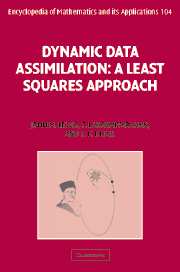Book contents
- Frontmatter
- Contents
- Preface
- Acknowledgements
- PART 1 GENESIS OF DATA ASSIMILATION
- PART II DATA ASSIMILATION: DETERMINISTIC/STATIC MODELS
- PART III COMPUTATIONAL TECHNIQUES
- PART IV STATISTICAL ESTIMATION
- PART V DATA ASSIMILATION: STOCHASTIC/STATIC MODELS
- PART VI DATA ASSIMILATION: DETERMINISTIC/DYNAMIC MODELS
- 22 Dynamic data assimilation: the straight line problem
- 23 First-order adjoint method: linear dynamics
- 24 First-order adjoint method: nonlinear dynamics
- 25 Second-order adjoint method
- 26 The 4DVAR problem: a statistical and a recursive view
- PART VII DATA ASSIMILATION: STOCHASTIC/DYNAMIC MODELS
- PART VIII PREDICTABILITY
- Epilogue
- References
- Index
24 - First-order adjoint method: nonlinear dynamics
from PART VI - DATA ASSIMILATION: DETERMINISTIC/DYNAMIC MODELS
Published online by Cambridge University Press: 18 December 2009
- Frontmatter
- Contents
- Preface
- Acknowledgements
- PART 1 GENESIS OF DATA ASSIMILATION
- PART II DATA ASSIMILATION: DETERMINISTIC/STATIC MODELS
- PART III COMPUTATIONAL TECHNIQUES
- PART IV STATISTICAL ESTIMATION
- PART V DATA ASSIMILATION: STOCHASTIC/STATIC MODELS
- PART VI DATA ASSIMILATION: DETERMINISTIC/DYNAMIC MODELS
- 22 Dynamic data assimilation: the straight line problem
- 23 First-order adjoint method: linear dynamics
- 24 First-order adjoint method: nonlinear dynamics
- 25 Second-order adjoint method
- 26 The 4DVAR problem: a statistical and a recursive view
- PART VII DATA ASSIMILATION: STOCHASTIC/DYNAMIC MODELS
- PART VIII PREDICTABILITY
- Epilogue
- References
- Index
Summary
In this chapter we extend the first-order adjoint method developed in the context of linear dynamical systems in Chapter 23 to the case of general nonlinear dynamical systems. Since most of the models of interest in research and operations are nonlinear, the contents of this chapter are especially applicable to real world problems.
In Chapter 23 we have brought out the similarities and differences between the two methods – the Lagrangian approach and the adjoint operator theoretic approach – for computing the gradient of the functional representing the desired criterion. Since we have featured the Lagrangian method twice – in Chapters 22 and 23 – we use the adjoint operator theoretic approach in this chapter. Our decision to use alternate approaches in different chapters is driven by two goals. First it provides variety and is hopefully more stimulating to the reader. Second, and more importantly, it enables the reader to acquire dexterity with the spectrum of tools that can be applied to real world problems.
The statement of the inverse problem is contained in Section 24.1. The first-order perturbation method for quantifying the growth of error is described in Section 24.2. Computation of the gradient using the adjoint method and an algorithm for minimization are given in Section 24.3 and 24.4 respectively. In Section 24.5, we introduce the reader to computation of model output sensitivity via adjoint modeling, i.e., the change of model output with respect to elements of the control vector.
- Type
- Chapter
- Information
- Dynamic Data AssimilationA Least Squares Approach, pp. 401 - 421Publisher: Cambridge University PressPrint publication year: 2006

